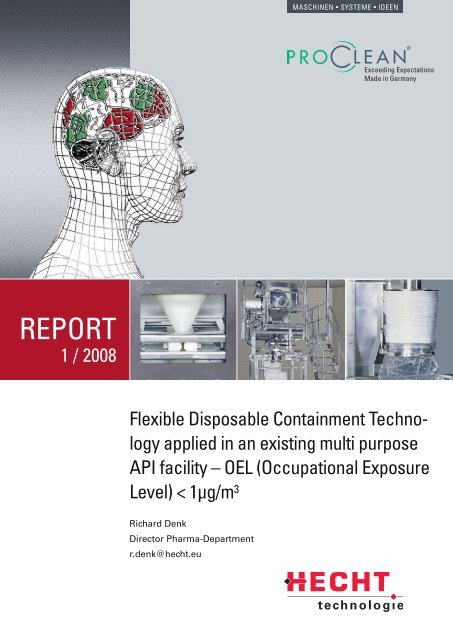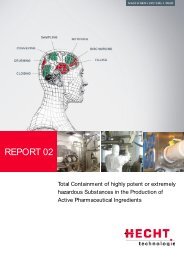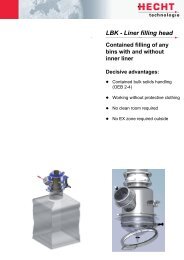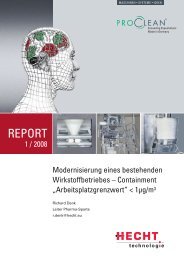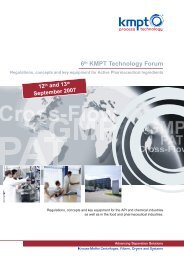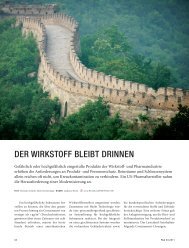Download PDF 1,8 MB - HECHT Technologie GmbH
Download PDF 1,8 MB - HECHT Technologie GmbH
Download PDF 1,8 MB - HECHT Technologie GmbH
- No tags were found...
You also want an ePaper? Increase the reach of your titles
YUMPU automatically turns print PDFs into web optimized ePapers that Google loves.
MASCHINEN • SYSTEME • IDEEN<br />
Exceeding Expectations<br />
Made in Germany<br />
REPORT<br />
1 / 2008<br />
Flexible Disposable Containment Technology<br />
applied in an existing multi purpose<br />
API facility – OEL (Occupational Exposure<br />
Level) < 1µg/m 3<br />
Richard Denk<br />
Director Pharma-Department<br />
r.denk@hecht.eu
REPORT 1 / 2008<br />
Closed System Solutions for Highly Hazardous Substances<br />
„Made in Germany“<br />
American Pharmaceutical Manufacturer uses Closed<br />
Systems for the benefit of Operator Safety and for preventing<br />
Cross-Contamination.<br />
As a result of the growing number of products which are<br />
classified hazardous and highly hazardous for employees<br />
in the active substance (API)- and pharmaceutical industries,<br />
the demand for product and operator safety is<br />
constantly increasing. In the United States, the Food and<br />
Drug Administration (FDA) monitors and regulates the<br />
producers of Active Pharmaceutical Ingredients and<br />
pharmaceuticals. The FDA is also acting outside the U.S.<br />
when a manufacturer plans to launch a pharmaceutical<br />
product into the American market.<br />
For some years now, the FDA has been requesting<br />
stronger integration of Closed Systems in the U.S. for<br />
the handling of hazardous and highly hazardous substances.<br />
The risk of cross contamination cannot be excluded in<br />
clean rooms either. Clean rooms and lock systems are<br />
merely secondary resources. Cross contamination,<br />
which originates from carrying objects to the production<br />
area or from employees, cannot be prevented. Especially<br />
in the manufacturing process of substances such as cytotoxic<br />
beta-lactham, teratogenic substances as well as<br />
antibiotics in multipurpose plants, the regulatory authorities<br />
have highest concerns if products are temporarily<br />
handled in open condition.<br />
Customer Requirements OEB5, OEL < 1µg/m³<br />
2
Flexible Containment Solutions<br />
as Product and Operator Safety<br />
Reactor Charging<br />
<br />
Transfer System<br />
<br />
Sampling<br />
Warehouse<br />
<br />
Centrifuge<br />
Discharge<br />
<br />
Dryer<br />
Filling<br />
Reactor<br />
Reactor<br />
Centrifuge<br />
To be able to produce highly hazardous substances<br />
which require a very low containment level of 1µg/m³ (the<br />
average OEL measured over a period of 8 hours), an existing<br />
manufacturing facility processing active substances<br />
required a complete redesign of their powder transfer<br />
equipment. The containment requirement included the<br />
equipment processing the starting material up to the finished<br />
substance API (Active Pharmaceutical Ingredient).<br />
For the integration of a suitable closed system, the existing<br />
structure of the building and the customized demands<br />
concerning raw-materials, intermediates and final products<br />
were taken into consideration. The basic materials<br />
are acquired from all over the world and there are no<br />
standard packaging norms. The possibility could not be<br />
ruled out that the operator gets in contact with a substance<br />
when opening the packaging material which, for<br />
example, were filled improperly by a supplier. Some<br />
products compact in the packaging material and require<br />
delumping before entering the manufacturing process.<br />
Another focus was the cleaning of the facility in order to<br />
minimize the set-up- and down-times when changing the<br />
product. For planning, the customer placed an order for<br />
detailengineering first and then decided to appoint us<br />
general contractor.<br />
Dryer<br />
The product brief included the<br />
following Containment solutions:<br />
<br />
Dryer<br />
Discharge<br />
and Filling<br />
in Drums<br />
the sampling of starting materials,<br />
the transfer from drums to FIBCs,<br />
the charging of reactors,<br />
the discharge of centrifuges,<br />
the filling of dryers,<br />
the discharge of dryers into small quantity<br />
receptacles.<br />
3
REPORT 1 / 2008<br />
Closed Sampling of<br />
the Starting Materials<br />
As solution for the sampling from drums with inner<br />
liners, a flexible protective liner technology was chosen.<br />
This protective liner system is a primary Containmentsystem.<br />
The protective liner technology protects the<br />
product from contamination originating from the environment<br />
and the operator from hazardous substances.<br />
The protective liner for sampling is fitted with two<br />
gloves, a sampling liner sleeve and a connection to the<br />
small dust filter cartridge. Inside the protective liner<br />
there is a bag for tools required for sampling.<br />
The protective liner is<br />
designed as one-way<br />
system and therefore<br />
needs no cleaning. A<br />
validation of cleaning, as<br />
customary in the pharmaceutical<br />
or API trade,<br />
is not necessary.<br />
The protective liner is fixed in a sampling unit. After<br />
opening the drum, the outer liner (not the product liner)<br />
is turned inside out over the edge of the drum and fixed.<br />
The end of the protective liner is joined with the outer<br />
liner of the drum by adhesive tape. The dust filter cartridge<br />
is connected to a larger external dust filter system.<br />
By using the gloves, the operator opens the product liner<br />
and starts the sampling. After sampling is completed,<br />
the liner sleeve is clamped twice with special closures<br />
and cut in the center between the closures. If there is no<br />
further sampling necessary, the product liner is closed<br />
again. The protective liner is evacuated and removed, together<br />
with the outer liner, from the edge of the drum.<br />
The outer liner is closed now with two special closures<br />
and cut in the centre between the closures. The drum is<br />
sealed with the drum lid.<br />
The outer liner is opened and<br />
turned inside out over the<br />
edge of the drum.<br />
The protective liner is turned<br />
inside out over the drum and<br />
fixed at the outer liner.<br />
Using the gloves, open the<br />
inner liner of the drum and<br />
take a product sample.<br />
Comparison of Protection <strong>Technologie</strong>s for product sampling<br />
Consumables<br />
25.000 $<br />
20.000 $<br />
15.000 $<br />
10.000 $<br />
5.000 $<br />
0 $<br />
Protective<br />
Liner<br />
Technology<br />
Isolator with<br />
Decontamination<br />
Unit<br />
Laminar Flow Unit<br />
with PPE and<br />
Decontamination<br />
Unit<br />
0 $ 100.000 $ 200.000 $ 300.000 $ Investment<br />
The part with the product sample<br />
is cut off at the end of the<br />
liner.<br />
The operator closes the inner<br />
liner via the gloves.<br />
After closing and cutting the<br />
protective liner twice, the protective<br />
liner system can be removed.<br />
4
Dispensing Unit for Starting Materials<br />
and Intermediates from Drums into FIBCs<br />
For the purpose of transfer and process-related weighing,<br />
the starting materials (raw-materials) or intermediates<br />
are taken to a transfer room. For containment of<br />
the products in the transfer area, a drum/sack transferisolator<br />
is provided for the various size drums used in<br />
the facility. All products are emptied in the isolator by<br />
force of gravity.<br />
An hygienic lump breaker breaks up any product agglomerates<br />
to a size suitable for weighing and metering<br />
into the intermediate FIBC. Between the lump breaker<br />
and the metering system there is a safety screen to sieve<br />
any large agglomerates which may have passed through<br />
the delumper.<br />
Lump Breaker<br />
The operator opens the drum and connects the protective<br />
liner system and the drum with a liner tube. With the<br />
gloves of the transfer isolator, the operator pulls the<br />
residual liner into the isolator and disposes it in a waste<br />
bag. Subsequently, the drum is pushed into the isolator<br />
via the tipping device until the operator, still wearing the<br />
gloves, is able to reach and open the drum and inner<br />
liner.<br />
<br />
<br />
<br />
<br />
<br />
Once the discharge is completed, the drum is closed<br />
and removed from the isolator, the protective liner is<br />
clamped twice and cut off in the centre between the closures.<br />
The one half of the protective liner serves as closure<br />
at the isolator; the other half of the protective liner<br />
serves as closure at the drum. The discharged product is<br />
prepared by the lump breaker and the safety screen in<br />
order to be weighed-in into the FIBC by means of the<br />
Q-Dos, a hygienic metering system. The Q-Dos consists<br />
of a flexible tube which is opened and closed externally<br />
by two variably controlled pneumatic cylinders. For precision<br />
metering, the cross-section is narrowed on one side<br />
and thus the metering flow reduced. For finest precision<br />
metering, the cross-section of the Q-Dos is narrowed further<br />
and completely closed after the desired product<br />
quantity is transferred to the intermediate receptacle.<br />
Protective Liner System for the Discharge of Drums<br />
Transfer Isolator, Lump Breaker, Q-Dos Metering<br />
System, LBK, Weighing System for the FIBC<br />
At the back of the isolator there is a protective liner connecting<br />
system which is closed with the residual liner of<br />
the previous protecting liner. By means of a drum liftingand<br />
tipping device, the drum is positioned directly in<br />
front of the protective liner connecting system.<br />
Q-Dos Metering System<br />
open<br />
closed<br />
5
REPORT 1 / 2008<br />
LBK<br />
Liner Filling Head<br />
For the closed filling of FIBCs in the dispensing unit and<br />
for the discharge of the centrifuges.<br />
For intermediate packaging, FIBCs with inner liners were<br />
selected because they are most suitable for filling, discharge<br />
and storage of the various types of products. The<br />
purchasing price is low in contrast to other systems,<br />
such as IBCs. There is no cleaning required for each FIBC<br />
is only used once.<br />
For the safe connection of the FIBC, the Liner Filling<br />
Head (LBK) was integrated. The inliner of the FIBC is<br />
connected to the Liner Filling Head with a tension ring.<br />
After filling, the operator<br />
closes the liner inlet<br />
twice at a short distance<br />
and cuts it off in<br />
the centre between the<br />
closures. A residual<br />
liner remains at the<br />
Liner Filling Head. The<br />
Liner Filling Head and<br />
the FIBC are sealed<br />
from the surrounding<br />
Closure Toolkit<br />
environment. The next<br />
FIBC is connected with a new tension ring over the residual<br />
liner. Subsequently, the residual liner is isolated<br />
and disposed of via a side hand access opening.<br />
Connecting the Liner.<br />
Connecting the Removal Bag for the Residual Liner.<br />
Removing the Residual Liner from the<br />
Hand Access Opening.<br />
Removing the Residual Liner from the Product Pipe.<br />
Securing and Filling.<br />
Closing and Cutting the Liner.<br />
6
FIBCs as In-Plant<br />
Packaging Handling-System<br />
Sequence of<br />
Operation LAS<br />
The filled FIBC is taken from the dispensing unit to the<br />
stand-by room. Depending on the requirement, the FIBC<br />
is identified by a bar-code system and carried into the<br />
corresponding room for reactor charging. A containment<br />
discharge system consisting of lifting column and Liner<br />
Connecting System (LAS) is installed in each reactor<br />
room. The lifting column picks up the FIBC and positions<br />
it at the discharge system. Moreover, the lifting column<br />
is needed to balance the stretching of the FIBC during<br />
the discharging process.<br />
The inliner of the FIBC is connected to the Liner Connecting<br />
System (LAS) with a tension ring. A mechanical agitation<br />
unit optimizes the product flow. When the FIBC is<br />
empty, it is evacuated. The operator closes the liner outlet<br />
twice at a short distance and cuts it off in the centre<br />
between the closures. A residual liner remains at the<br />
Liner Connecting System (LAS). The Liner Connecting<br />
System and the empty FIBC thus are sealed off from the<br />
surrounding environment. The next FIBC is connected<br />
below the previous residual liner with a new tension<br />
ring. The residual liner is isolated and disposed of<br />
through a side hand access opening.<br />
Fix the inner liner of the FIBC with a<br />
new tension ring in the lower groove.<br />
+<br />
Remove the residual liner with the liner bag.<br />
<br />
<br />
Pull out the residual liner and the<br />
tension ring with the removal bag.<br />
<br />
<br />
Secure and FIBC discharge.<br />
<br />
<br />
<br />
Lifting column, FIBC Upper transport frame,<br />
FIBC, Mechanical agitation, LAS,<br />
Lower Transport frame for the FIBC, Reactor<br />
After discharge, close the liner twice and<br />
cut it off in the centre between the closures.<br />
7
REPORT 1 / 2008<br />
Centrifuge-Discharge and<br />
Dryer-Filling in one Unit<br />
Dryer Discharge with<br />
Endless Liner-Technology<br />
Special requirements existed for discharging product<br />
from the centrifuge directly into the dryer below or alternately<br />
into a separate FIBC.<br />
<br />
<br />
<br />
<br />
<br />
<br />
<br />
Centrifuge Discharge, LBK for FIBC Filling, Lifting<br />
column, FIBC Upper transport frame, FIBC,<br />
Mechanical agitation, LAS for FIBC Discharge,<br />
Dryer Filling, Lower Transport frame for the FIBC<br />
<br />
<br />
After drying, the produced API is to be weighed-in into a<br />
fibre-drum. For this purpose, an endless liner system<br />
with Q-Dos metering system was chosen. Before entering<br />
the metering system, the product is first sampled via<br />
small bags (endless liner) and fed through an inline turbulent<br />
sieving machine. For maintenance purposes, the<br />
metering system, sieving machine and sampler can be<br />
adjusted to operating height with an integrated post<br />
hoist. The endless liner system is fitted with a liner cartridge<br />
which includes up to 80 meters (240 feet) of liner.<br />
The closed liner end is pulled into the fiber drum by the<br />
operator and is inflated with nitrogen in order to prepare<br />
an optimal filling of the drum. After filling with the<br />
Q-Dos system, the operator pulls a clean liner from the<br />
liner cartridge. A bag sealer closes the filled bag at the<br />
same time, creates a new bag bottom and separates the<br />
bags from each other. Now, the operator again pulls a<br />
sufficient quantity of liner from the liner cartridge into<br />
the drum and the filling procedure can start again.<br />
<br />
The discharge of the centrifuge into the dryer is carried<br />
out via an empty FIBC which is connected with the Liner<br />
Filling Head (LBK) at the inlet and with the Liner Connecting<br />
System (LAS) at the outlet. The empty FIBC<br />
serves as buffer if the dryer cannot be filled directly. By<br />
means of a mechanical agitation unit even moist product<br />
which tends to bridge can be loaded into the dryer. The<br />
option also exists to only fill the FIBC and discharge the<br />
product into another dryer. This solution provides the<br />
pharmaceutical manufacturer with optimum flexibility<br />
of operation.<br />
<br />
<br />
<br />
<br />
<br />
Turbulent seeving machine, Q-Dos metering<br />
System, Lifting column, Endless Liner System,<br />
Bag sealer, Weighing System<br />
8
Endless Liner Filling<br />
with Tensioning Bands<br />
Cleaning the<br />
Containment Systems<br />
Basic position<br />
Pull liner to the bottom of the drum.<br />
Inflate and make the atmosphere inert.<br />
Filling<br />
Close twice with the clamping tool.<br />
Cut off in the center between the closures.<br />
Special concepts were developed to ensure a contamination-free<br />
cleaning and maintenance. The cleaning is done<br />
with WIP-screens which can be attached in a closed manner.<br />
Through a specific WIP/CIP study, the cleaning nozzles<br />
were placed at the most appropriate positions. After<br />
the cleaning, filtered air is provided via the cleaning units<br />
to dry the systems. After cleaning and drying, the systems<br />
are opened for wipe tests and maintenance.<br />
<br />
All from one Source reduces the<br />
Planning- and Manufacturing Costs<br />
<br />
Working with one supplier for the design engineering<br />
and equipment supply for the Containment solution not<br />
only substantially reduced the costs of the project but<br />
also the installation and start-up of the equipment were<br />
accomplished earlier than planned. The direct contact<br />
between the supplier and the customer resulted in a<br />
timely flow of information during the project, and<br />
allowed the supplier to scrutinize every aspect of the<br />
installation in detail. In doing so, weak points in other<br />
areas were identified and corrected as necessary.<br />
As a result, the estimated planning- and implementation<br />
costs could be reduced by approx. 30 %.<br />
Comparison of the total investment and life cycle cost<br />
Investment<br />
9.000.000 $<br />
8.000.000 $<br />
7.000.000 $<br />
6.000.000 $<br />
IBC Ridget Containment<br />
5.000.000 $<br />
4.000.000 $<br />
3.000.000 $<br />
2.000.000 $<br />
Flexible Containment (FIBC)<br />
1.000.000 $<br />
0 $<br />
0 year 1 year 2 year 3 year 4 year 5 year 6 year 7 year 8 year 9 year 10 year Life cycle cost<br />
9
REPORT 1 / 2008<br />
Excerpt from our<br />
range of products<br />
LBK filling head<br />
for closed filling of Big Bags as well as<br />
drums and boxes with liners installed.<br />
LAS connecting system<br />
for the contained discharge from Big Bags<br />
and plastic containers.<br />
SAS protective liner<br />
connecting system<br />
for filling and discharge of Big Bags as well<br />
as other containers. Containment is ensured<br />
by using protective liner.<br />
Sack and drum discharge<br />
using a discharge station with gloves and<br />
protective liner entry system. All containers<br />
can be brought in and discharged without<br />
locking system.<br />
Drum filling<br />
with glove box for safe filling. The station<br />
is complete including integrated screening<br />
machine and sampler.<br />
Isolator technology<br />
for the highest containment for filling and<br />
discharge of Big Bags.<br />
10
Process technology and engineering<br />
for the basic handling of raw materials and bulk solids as well<br />
as special designed production processes involving active products.<br />
We have many custom designed systems in operation<br />
throughout the world.<br />
Service<br />
Preventative maintenance, repair, assembly, commissioning<br />
and training are done by our service technicians. Of course, we<br />
are pleased to support you in checking and modernizing older<br />
stations.<br />
The clean system<br />
in bulk solid handling<br />
ProClean ® is the quality sign for customer-specific solutions<br />
for high value tasks in the pharmaceutical, chemical<br />
and nutrition industries. The highest requirements<br />
for hygiene, personnel and product safety, consistent<br />
production and exceptional equipment quality are standards<br />
when developing the <strong>HECHT</strong> ProClean ® systems.<br />
Engineering – high value from a single source<br />
During the past 30 years <strong>HECHT</strong> has consistently supplied high value technology based on professional engineering.<br />
Our long term experience in process engineering has made us specialists in the areas of material logistics and process<br />
engineering. Our flexibility, speed and efficiency are the keys for your company’s success!<br />
Whatever your material handling need, you can count on us.<br />
11
MASCHINEN • SYSTEME • IDEEN<br />
FLEXIBLE<br />
CONTAINMENT TECHNOLOGY<br />
CLOSED<br />
SYSTEMS<br />
FLEXIBLE<br />
CONTAINER HANDLING<br />
HIGH<br />
CONTAINMENT<br />
OPTIMAL<br />
SOLUTIONS<br />
FLEXIBLE<br />
AND SAVE<br />
08-0020 | E | design©www.adverma.de<br />
Containment solutions<br />
for sacks and drums<br />
■ Filling station for drums with continuous liner.<br />
■ For clean and exact filling of drums, bags and boxes<br />
in manual or fully automatic mode.<br />
For further information please visit our website under www.hecht.eu/proclean<br />
<strong>HECHT</strong> <strong>Technologie</strong> <strong>GmbH</strong><br />
Schirmbeckstraße 17<br />
85276 Pfaffenhofen/Ilm · Germany<br />
Phone +49 84 41-89 56-0<br />
Fax +49 84 41-895656<br />
E-Mail<br />
Internet<br />
info@hecht.eu<br />
www.hecht.eu


